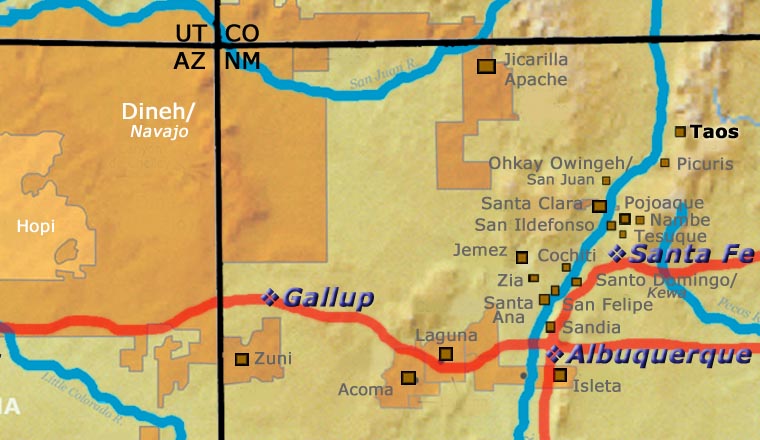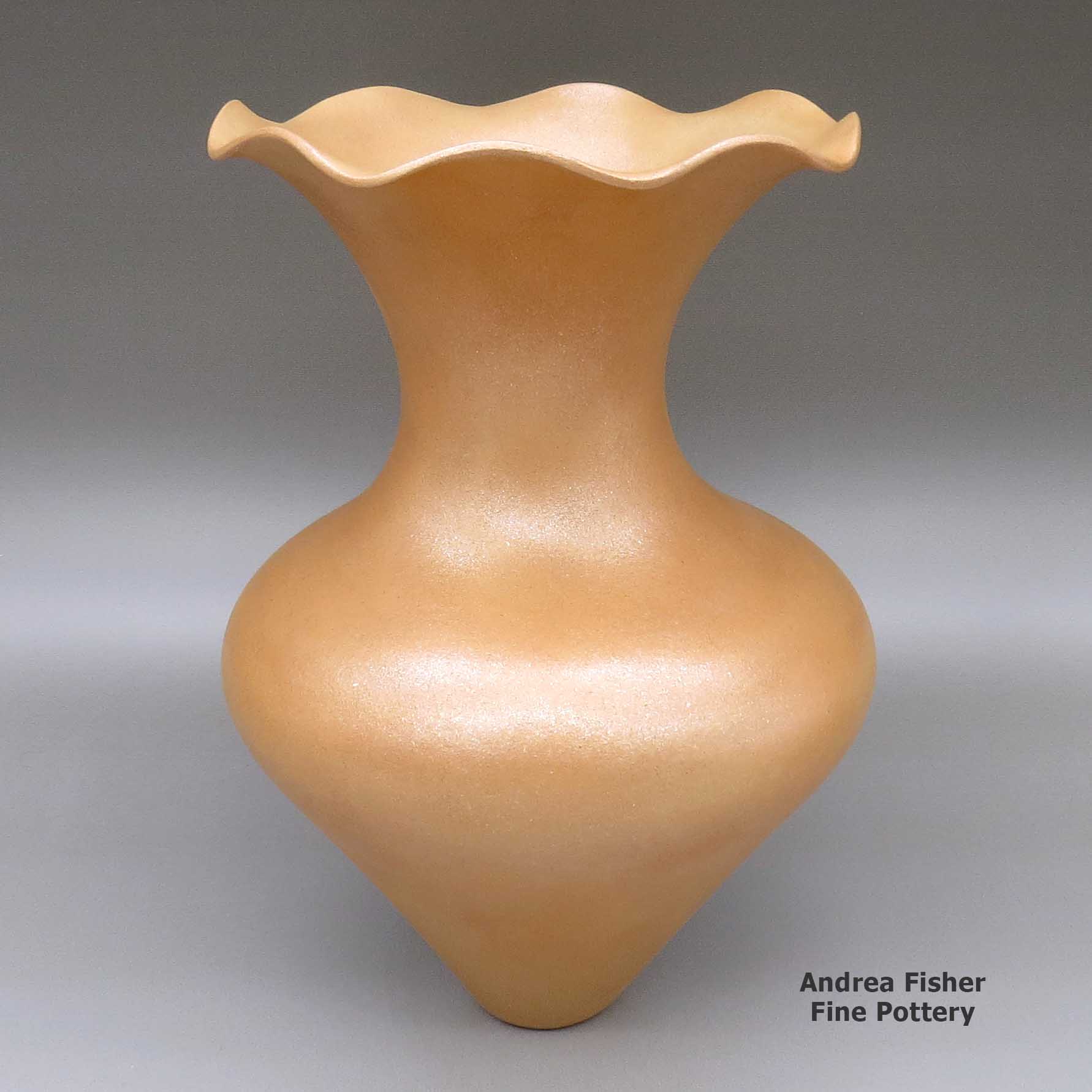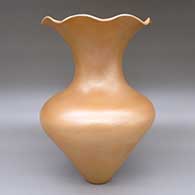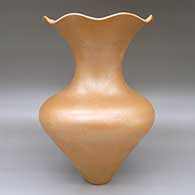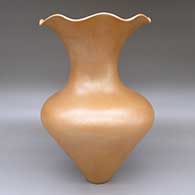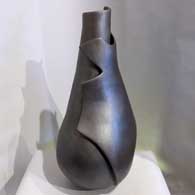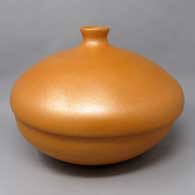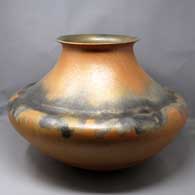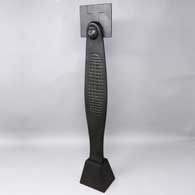
Angie Yazzie
Taos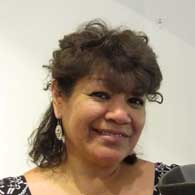
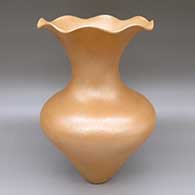
Angie Yazzie was born into Taos Pueblo in 1965. Her parents were Mary A. Archuleta of Taos Pueblo and Nick Yazzie of the Dineh (Navajo). In keeping with Pueblo tradition Angie was raised at Taos Pueblo.
Angie tells us she began making pottery when she was nine years old after being introduced to the basics by her mother and her maternal grandmother, Isabel Archuleta. Angie said she lived with her maternal grandparents for several years as a child and through them and their shop at the pueblo, she was exposed to the whole range of Pueblo arts and crafts. Clay Mother, though, is who Angie has heard calling her to work all these years.
After learning the barest basics, Angie struck out on her own and learned to make large golden and black micaceous ollas, like the ollas Taos was famous for making a hundred and more years ago. Micaceous clay has tiny flecks of mica spread throughout the clay. That mica makes it possible for a pueblo pot to hold liquids for cooking or storing. There are two seams of micaceous clay on the lands of Taos Pueblo: one golden and one black.
Angie has told us her favorite shape to make is a large, fluted water jar, slipped with micaceous clay. It is exactly that type of jar that has earned her Best of Division and First Place ribbons at the Heard Museum Guild Indian Art Fair, Best of Division and First, Second and Third Place ribbons at the SWAIA Santa Fe Indian Market and First Place ribbons at the Eight Northern Pueblos Arts and Crafts Show. Angie recently had a piece placed on display at the Winona State College Museum in Winona, Minnesota.
Angie says she still gets her inspiration from her fond memories of her maternal grandmother. At the same time, she loves to look at other artists creations and talk to them about how they made it.
Some of the Awards Angie has Earned
- 2020 Heard Museum Guild Indian Fair & Market: Judge's Award - Upton Ethelbah Greyshoes, Jr. Awarded for artwork: "Give Me Water"
- 2018 Santa Fe Indian Market: Classification II - Pottery, Division A - Traditional Unpainted Pottery, Category 502 - Micaceous Ware in the style of Taos, Nambe, Picuris, any form: First Place
- 2018 Heard Museum Guild Indian Fair & Market, Classification II - Pottery, Division B - Unpainted, including ribbed, native clay, hand built, fired out-of-doors: First Place. Awarded for artwork: Black Fluted Vase
- 2018 Heard Museum Guild Indian Fair & Market, Classification II - Pottery, Division G - Pottery miniatures not to exceed three (3) inches at its greatest dimension: Honorable Mention. Awarded for artwork: Rectangle Prayer Plate
- 2017 Santa Fe Indian Market: Classification II - Pottery: Best of Classification
- 2017 Santa Fe Indian Market: Classification II - Pottery, Division A - Traditional Unpainted Pottery: Best of Division
- 2017 Santa Fe Indian Market: Classification II - Pottery, Division A - Traditional Unpainted Pottery, Category 502 - Micaceous Ware in the style of Taos, Nambe, Picuris, any form: First Place
100 West San Francisco Street, Santa Fe, New Mexico 87501
(505) 986-1234 - www.andreafisherpottery.com - All Rights Reserved

Taos Pueblo
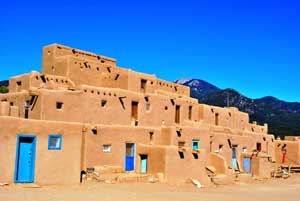
Taos Pueblo
Taos Pueblo consists of two main structures, both of which are counted among the oldest continuously inhabited structures in the United States. The location straddles the Rio Pueblo de Taos (also known as Red Willow Creek), whose headwaters rise in the nearby Sangre de Cristo Mountains. The pueblo was designated a National Historic Landmark on October 9, 1960 and was designated a UNESCO World Heritage Site in 1992.
The people of Taos Pueblo speak Northern Tiwa, a member of the Tanoan family of languages. It is felt the tribe migrated to the area during the time of the Great Drought in the Four Corners region, the same drought that essentially forced nearly all the Pueblo peoples to migrate to the Rio Grande, Rio Puerco or Little Colorado River areas.
Taos Pueblo was a center of trade long before the Spanish arrived. The pueblo served as a central contact point between the Rio Grande Pueblos to the south and the Cheyenne, Arapaho, Comanche, Apache and Ute to the north and northeast. Every fall when the annual trade fair was happening, Taos Pueblo became a neutral zone where fighting and raiding were banned for the duration of the fair. The arrival of the Spanish in 1540 didn't interfere with the trade fair cycle although the Spanish did try to impose taxes on everyone.
Around 1620 Jesuit priests oversaw the construction of the first mission of San Geronimo de Taos. Friction between the tribe and the Spanish led to the killing of the resident priest and destruction of the church in 1660. The priests rebuilt the church only to have the church destroyed again and two resident priests killed in the beginning of the Pueblo Revolt of 1680. The Spanish were evicted from northern Nuevo Mexico in 1680 but returned in force in 1692. By 1700, the third mission church was being built. For a few years the tribe and the Spanish got along, forced to be amicable in order to deal with their common enemies: the Ute and Comanche tribes. That pressure was relieved in 1776 when Governor Juan Bautista de Anza and his troops killed virtually the entire upper hierarchy of the Comanche tribe in the Battle of Cuerno Verde, near Greenhorn Mountain in southern Colorado.
American fur trappers and traders first appeared in the area around 1820 and the American military arrived in 1847, during the outbreak of the Mexican-American War. That military presence led shortly to the Taos Rebellion in 1847, a rebellion which saw Governor Charles Bent and several other prominent Americans killed. A few days later American troops and armed citizens arrived from Santa Fe and, thinking the rebels had taken refuge in the San Geronimo de Taos church, they bombarded the church, destroying it and killing many innocent women and children who actually were hiding inside. That effectively ended the rebellion. After a short trial, 17 of the surviving rebels were hanged from trees surrounding the plaza in the adjacent non-Indian village of Taos.
A new mission church was constructed around 1850 near the west gate of the pueblo wall but the ruins of the old church are still visible today.
One result of the Taos Rebellion is that the tribe has never signed a peace treaty with the United States Government. That led to President Theodore Roosevelt using an Executive Proclamation to remove some 48,000 acres of the pueblo's mountain land and combine that with the fledgling Carson National Forest in 1906. That land was a point of major contention between the pueblo and Congress until it was returned to the tribe by President Richard M. Nixon in 1970. An additional 764 acres was returned to the tribe in 1996.
Today the community of Taos Pueblo is considered one of the most private, secretive and conservative of all the pueblos, even though the Pueblo of Taos offers more shops for visitors than any other pueblo.
Taos potters have been making pottery for hundreds of years, much of it slipped with micaceous clay so that it could be used for cooking purposes. For many years Taos pottery was traded to the Apache, Ute, Arapaho and Comanche who came to the annual Taos trade fair in return for buffalo meat and buffalo hides. Traditional Taos micaceous pottery is known for its glittery tan or yellow gold appearance. Generally there was no painted decoration but there might be some form of sculpted detail. Today's Taos potters produce a variety of traditional micaceous pots.
100 West San Francisco Street, Santa Fe, New Mexico 87501
(505) 986-1234 - www.andreafisherpottery.com - All Rights Reserved

Taos
$ 3900
zzta3f080
Micaceous gold jar with a flared pie crust opening
10 in L by 10 in W by 14.75 in H
Condition: Excellent
Signature: Angie Yazzie Taos Pueblo
Date Created: 2023
100 West San Francisco Street, Santa Fe, New Mexico 87501
(505) 986-1234 - www.andreafisherpottery.com - All Rights Reserved
